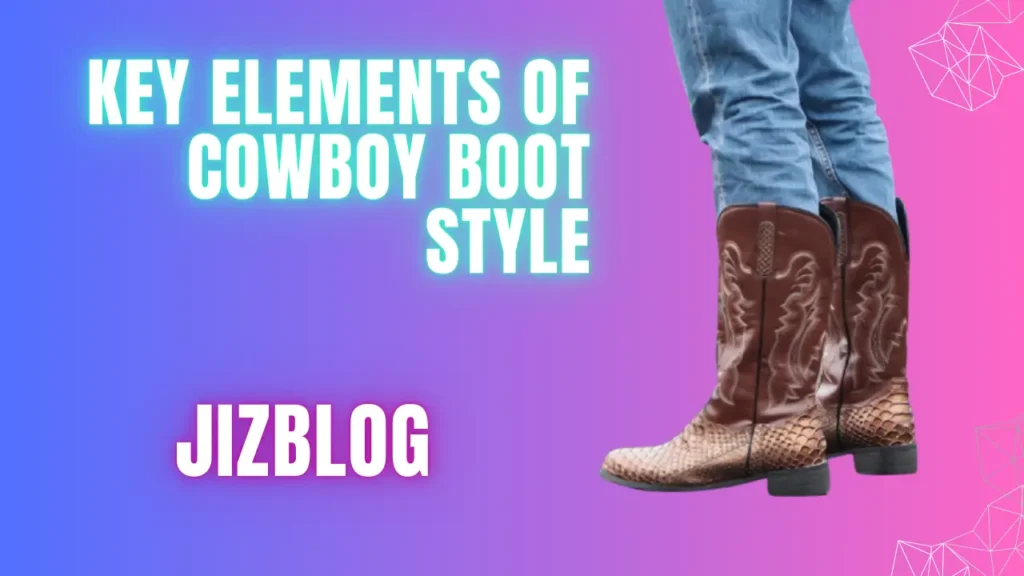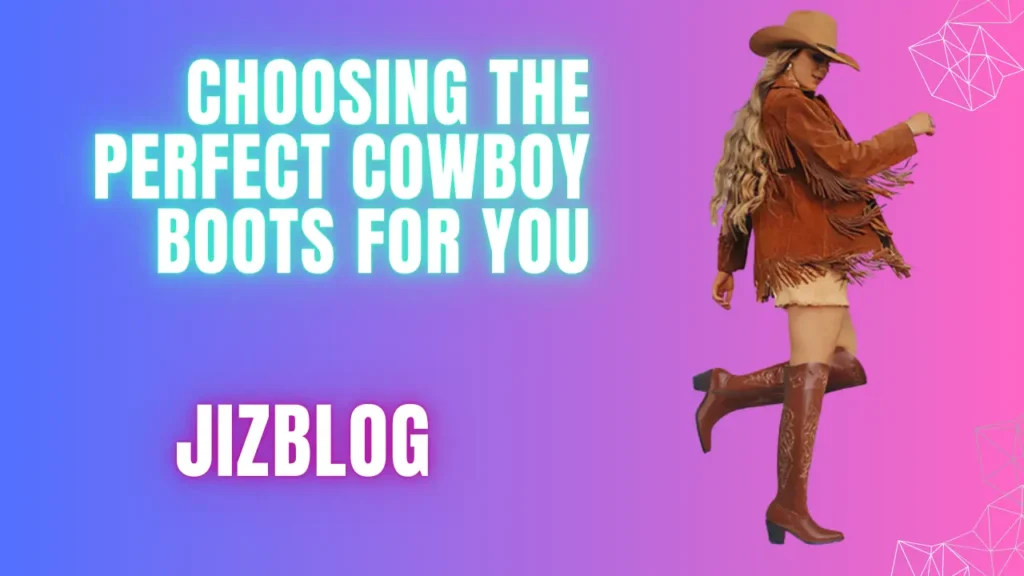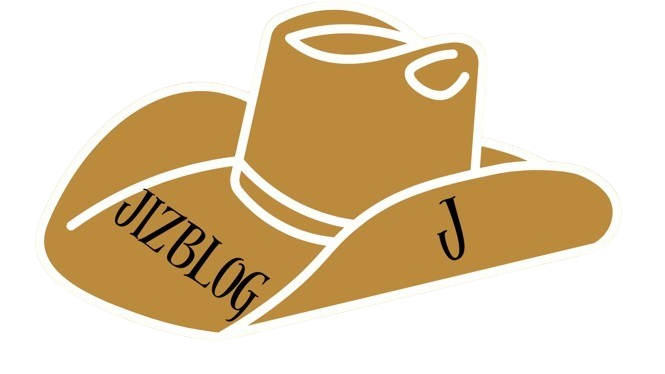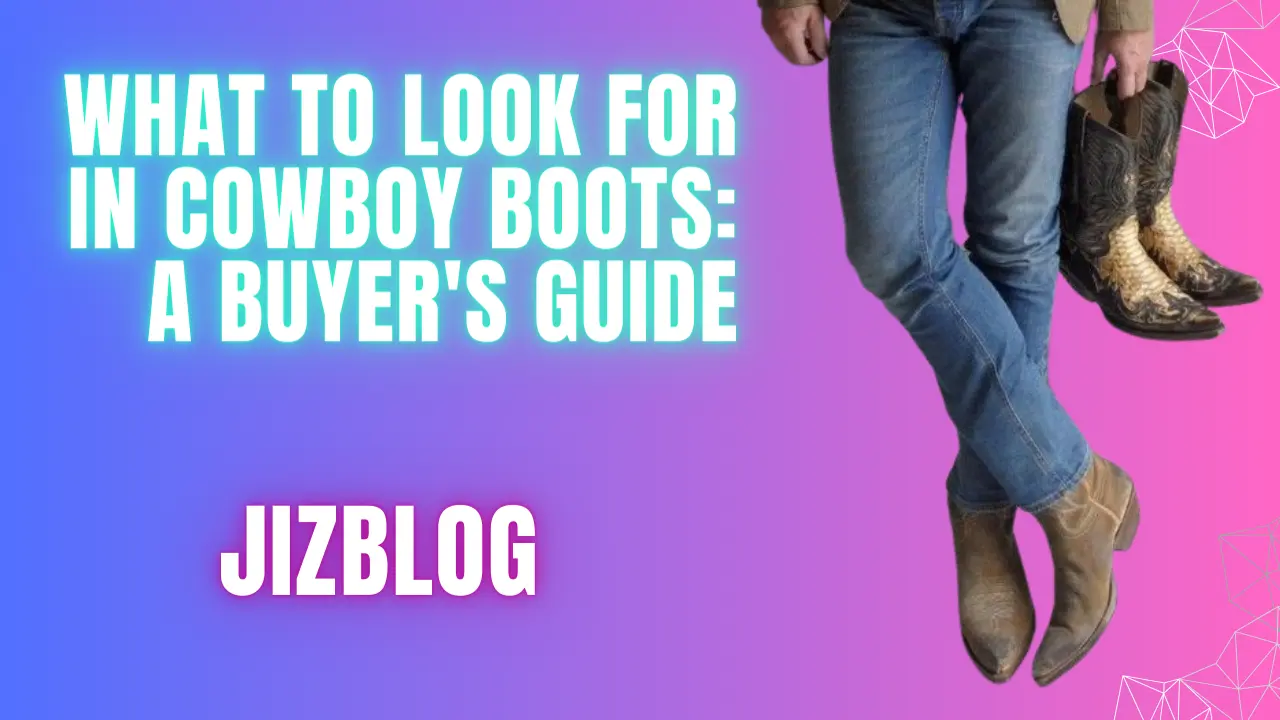Hi, guys! Ever found yourself lost in a sea of cowboy boots, wondering what to look for in cowboy boots? Well, you’re not alone, partner! I remember my first boot-shopping escapade—overwhelmed by rows of leather and rows of choices. In this post, we’re hitching our wagons to the essential factors that make a pair of cowboy boots top-notch. So, join me on this adventure as we navigate through style, fit, and quality, ensuring that the next time you’re on the hunt for the perfect pair, you’ll be well-equipped to spot the gems in the corral of options.
Factors to Consider When Shopping for Cowboy Boots
Fit and Sizing
Unlike regular shoes, cowboy boots fit differently and run large. When trying on boots, focus on getting a snug fit in the ball and instep, while allowing some wiggle room for your toes. The boot should slide on easily, but your foot shouldn’t be swimming in extra space.
Allow for a little heel slippage, around 1⁄4 to 1⁄2 an inch, since the leather will conform to your foot over time. Let your foot settle into the boot when walking around the store. An ideal fit means no pinching, rubbing, or pressure points.
Since sizes vary across brands, have your feet professionally measured whenever possible. If shopping online, carefully check size charts and review policies for trying on boots at home before committing to a non-returnable custom pair.
Boot Height
Cowboy boots come in different shaft heights, from ankle-height models to extra-tall 24-inch shafts. Shorter styles are easiest to wear, while tall boots make more of a statement. Consider your personal style and intended activities.
Ankle boots have a 5 to 7-inch shaft and are perfect for weekends or a night out. Mid-calf boots with a 10 to 14-inch shaft work well for both casual and dress settings. For a traditional cowboy look, choose a 16 to 18-inch tall boot. Extra tall boots over 20 inches are best suited for the rodeo arena.
Toes Styles
Pointed, rounded, or squared – cowboy boot toes come in all shapes. Pointed toes are the most iconic cowboy look. They visually elongate your legs and give boots a sleek silhouette.
Rounded toes offer more room for toes to spread out, creating a comfortable fit. Square toes have an unconventional, boxy shape best paired with modern outfits. Toe styles are a matter of both comfort and personal preference.
Table: Cowboy Boot Toe Shape Comparison
| Toe Type | Visual Profile | Amount of Toe Room | Style Pairings |
|---|---|---|---|
| Pointed Toe | Sleek, elongating | Snug fit | Dressy outfits |
| Rounded Toe | Curved end | Comfortable fit | Casual outfits |
| Square Toe | Boxy, flat end | Roomy fit | Modern outfits |
Heel Shapes
Cowboy boot heels also vary quite a bit. Here are some of the most common options:
- Walking Heels: Around 1 to 2 inches tall, these provide optimal comfort for all-day wear. Great for beginners.
- Riding Heels: Moderately angled 2 to 3-inch heels designed for stability when riding horses. A versatile go-to heel height.
- Stacked Heels: Block-heeled cowboy boots, usually 2 to 3 inches high. The stacked shape provides maximum support.
- Cuban Heels: Tall and angled dramatically like a zig-zag. Often 3 to 4 inches high. Not ideal for novices.
- No Heel (Flat): Eliminates heel completely for a minimalist look. Only recommended for very experienced wearers.
For first-time cowboy boot buyers, stick with a low block heel or angled heel under 3 inches. Taller heels take practice!
Soles
Cowboy boot soles can be leather or rubber. Each has pros and cons:
- Leather Soles: The traditional choice, great for dancing. Wears down over time. Not ideal for extensive walking. Require resoling.
- Rubber Soles: Extremely durable and shock-absorbent. Provide traction. Can’t be resolved but lasts very long. Extra weight.
Leather-soled boots are ideal for casual wear, while rubber soles excel for rugged activities. Also, consider adding a protective sole guard to prolong the life of leather soles.
Materials
Here are some of the most popular materials used to construct cowboy boots:
- Leather: Classic cowboy boot material, offers a stylish look. Types include full-grain, top-grain, and suede. Requires breaking in but molds to feet. Careful maintenance is needed.
- Exotic Skins: Luxury leather from animals like ostrich, alligator, lizard, etc. Very expensive but gorgeous.
- Synthetic Leather: Man-made faux leather alternative. Cost-effective and requires little maintenance. Not as breathable.
- Rugged Materials: Used for working cowboy boots, like distressed leather or rubber corded soles. Value durability over appearance.
- Fabric: Fun cowboy boots made from materials like denim, wool, or canvas. Limited wear but eye-catching.
Genuine leather like full-grain is ideal for dress boots, while synthetic leather or fabric suits occasional wear. Work boots demand hardy, rugged materials.
Boot Construction
These key construction elements impact quality and comfort:
- Goodyear Welt: The gold standard. Involves stitching from the upper to the sole for flexibility and the ability to resolve. Very durable.
- Cemented: Lower quality bonds upper to sole with glue rather than stitching. Not reasonable but costs less.
- Hybrid: Combines stitching at the front for flexibility with gluing at the back. Decent quality and resolvable.
- Handmade: Skilled craftsmen make boots by hand using artisanal methods. High-end quality and customized options.
For longevity, opt for Goodyear welt construction. But also consider your budget and needs – well-made cemented boots can still last with care.
Key Elements of Cowboy Boot Style

Now that you know how cowboy boots should fit and feel, it’s time to explore style options.
Western Wear Styles
- Classic Western: The quintessential cowboy boot is made from tanned leather, detailed stitching, and cowboy heels. Often decorated with intricate tooled designs.
- Work Boots: Rugged boots meant for ranching, riding, and labor. Made from durable, scuffed leather with minimal decoration. Focus on function.
- Biker Boots: Edgy modern cowboy boots that extend higher up the calf. Geared for motorcycle riders but make a bold fashion statement.
- Roper Boots: Feature a low, short heel and rounded toe. Comfortable enough for all-day wear. Great starter choice.
- Exotics: Luxury cowboy boots made from materials like an ostrich, alligator, lizard, and more. Flashy, expensive, and decorative.
- Distressed: Intentionally scuffed and marked-up leather. The worn-in look appeals to cowboy traditionalists.
Western boot styles range widely – from pretty traditional designs to tough, funky boots. Shop styles aligned with your personality.
Cowboy Boot Decoration
Artisan details give cowboy boots visual interest and flair:
- Stitching: Decorative stitching along shafts and vamps adds flair. Can be single, double, or triple stitched in colors contrasting the leather.
- Tooling: Intricate designs tooled (impressed) onto the leather through skilled handiwork. Displays images like flowers, animals, or Western scenes.
- Inlay: Material like silver, gold, bezels or stones inset into the leather for ornate embellishment. A true luxury detail.
- Overlay: Decorative layered leather sewn atop the base leather to form shapes like stars, leaves, or scrolls.
- Painting: Custom hand-painted designs in colors contrasting the base leather. From simple to complex scenes.
- Embossing: Textured patterns like basketweave, flames or haircalf embossed into the leather surface. Adds visual interest.
Whether you want a simple clean look or flashy embellishments, custom decorative details make boots one-of-a-kind.
Choosing the Perfect Cowboy Boots for You

The key to finding your dream cowboy boots is deciding exactly how you plan to wear them.
Casual Boots: For everyday wear, choose leather boots with a walking heel under 2 inches. Go for a more minimalist look without excessive decoration. Roper and mid-calf styles work well.
Fashion Boots: Want to make a statement? Opt for pointed toes, taller Cuban heels, and eye-catching embellishments like exotics, inlays or tooling. Higher shafts also draw attention.
Work Boots: If you need protective footwear for the job, look for rugged leathers, firm rubber soles, plain toes, and low-block heels. Durability trumps appearance.
Beginner Boots: New to cowboy boots? Stick with rounded roper toes, leather soles under 2 inches, and simpler styling. Get used to wearing boots before going bold.
Budget Boots: If price is a factor, lower costs by choosing synthetic leather over real leather. Or do minimal design customization beyond basic stitching or embossing.
No matter your needs, there is a perfect cowboy boot waiting for you. Follow this guide to narrow your choices to fit your personal cowgirl or cowboy style. Happy boot shopping!
Table: Common Cowboy Boot Heel Heights
| Heel Type | Heel Height Range | Best Use Cases |
|---|---|---|
| Walking Heel | 1 to 2 inches | All-day wear, beginners |
| Riding Heel | 2 to 3 inches | Casual wear, horse riding |
| Stacked Heel | 2 to 3 inches | Maximum support |
| Cuban Heel | 3 to 4 inches | Making a statement |
| No Heel/Flat | 0 inches | Very experienced wearers only |
Conclusion
Finding the right cowboy boots comes down to understanding your personal style and needs. Now that you know what to look for in cowboy boots in terms of fit, construction, materials, and embellishments, you can zero in on the ideal pair. For casual wear, go for comfort and minimal decoration. If making a statement is the goal, choose flashy embellishments and tall shafts. Work boots call for rugged leathers and rubber soles, while beginners should opt for low heels and simple styling. Don’t forget to factor in your budget. With so many options, there’s a cowboy boot out there perfect for you. Use this guide to find your dream pair and kick up your heels!
FAQ’s
What heel height is best for beginners?
Beginners should start with a low walking heel around 1-2 inches tall.
What sole is best for dancing in cowboy boots?
Leather soles are the traditional choice for dancing cowboy boots.
Should my toes feel cramped in new cowboy boots?
No, toes shouldn't feel cramped - pointed toes are elongated to allow toe room.
What is the shaft height of mid-calf cowboy boots?
Mid-calf cowboy boots have a shaft height of 10-14 inches.

